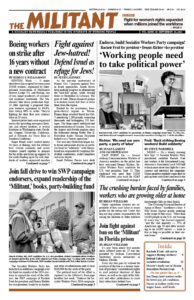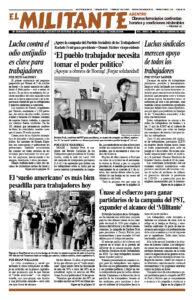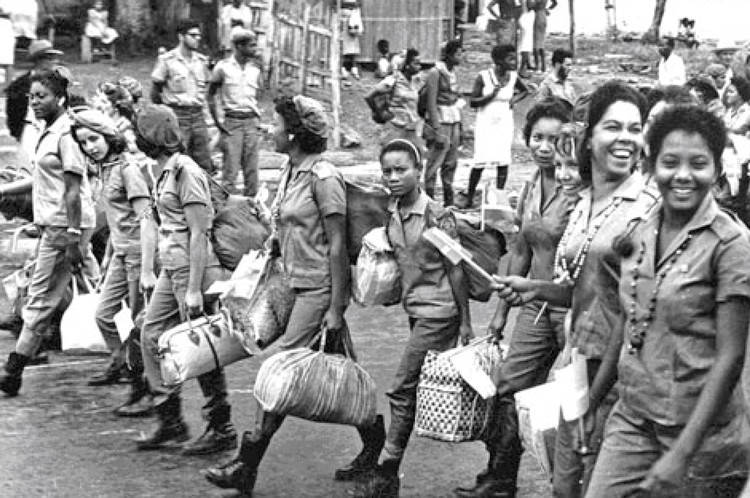Women and the Cuban Revolution is one of Pathfinder’s Books of the Month for September. It includes speeches and documents by Fidel Castro, the central leader of Cuba’s socialist revolution; Vilma Espín, the founding leader of the Federation of Cuban Women; and others. The book explains women’s changing role as workers and farmers took power in Cuba in 1959 and millions participated in a giant social transformation. The excerpt is from the introduction by Elizabeth Stone, the editor of the book and a leader of the Socialist Workers Party. Copyright © 1981 by Pathfinder Press. Reprinted by permission.
The women who joined the struggle to overthrow Batista not only had to have the courage to face the repression and torture of Batista’s police, but they also had to buck the prevailing prejudice against women’s involvement in politics. …
The women who fought against Batista were pioneers in making changes that were to effect millions of Cuban women later on. In his first speeches immediately after the revolution came to power, Castro paid homage to these women fighters and used their example to explain how the revolution was going to move forward to involve masses of women.
One of the first activities to draw in large numbers of women was the creation of the militia. As the revolution deepened with the carrying out of the land reform and the nationalization of large imperialist holdings, the U.S. government and counterrevolutionaries within Cuba began to organize armed opposition. Bombings, sabotage of factories, and the burning of sugarcane fields went hand-in-hand with the threat of military attack from the United States. To help counter this a popular militia was organized in the workplaces and schools, and women who worked or who were students joined it.
There was a big hue and cry from counterrevolutionary elements about women’s incorporation into the militia. They questioned the “morals” of women who dressed like men, wore pants, and carried guns. …
The intensification of the counterrevolutionary attacks led in September 1960 to the formation of the Committees for the Defense of the Revolution (CDRs). Even larger numbers of women joined the CDRs, which were organized on a block-by-block basis. They guarded public buildings, watched for suspicious activities in the neighborhoods, and carried out other important tasks of the revolution.
On August 23, 1960, another big step was taken with the formation of the Federation of Cuban Women (FMC). The FMC immediately began to organize masses of women, house by house, in the cities and the countryside, helping to build the militias and the CDRs, organizing the drive against illiteracy, setting up schools for peasant women, and establishing a network of child-care centers.
Because the FMC was an organization led by and made up entirely of women, those women who had never before participated in politics or other public activity often felt more at home in its ranks. The FMC also provided a place where women could discuss the problems they faced as women and press for changes to alleviate these problems. …
In 1961, the campaign to wipe out illiteracy was organized. It was a gigantic effort. A hundred thousand youth between the ages of ten and eighteen left their schools and went into the countryside as literacy brigadistas to teach people how to read and write. Over half of these brigadistas were girls and young women.
Fifty-five percent of those who learned to read and write were women. This was accomplished despite considerable resistance to including women in the campaign. …
For the young women and girls who went out to teach, the experience was a wrenching break from the past. Until then, some of them had not even been allowed out of the house alone. Now they were traveling to the most remote parts of the countryside and mountains, where they shared the life of poverty of the peasants, not only teaching but also working with them in the fields.
One of the slogans of the literacy brigadistas was “You will learn more than you teach,” and this turned out to be the case. They learned about the peasants’ life and work and returned to the cities with a better understanding of why the desperately poor areas of the countryside needed to be given preferential treatment by the revolution.
From the ranks of these teachers came new cadres for the revolution — youth who were more conscious of the challenges that lay ahead and ready to commit themselves to the necessary tasks. The campaign also deepened consciousness about the role of women in the revolution. …
[Castro explained:] “This revolution has really been two revolutions for women; it has meant a double liberation: as part of the exploited sector of the country, and second, as women, who were discriminated against not only as workers but also as women.”
Castro added that if women were doubly exploited under capitalism, then in a socialist revolution they would be “doubly revolutionary.”


